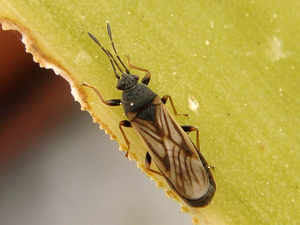Ischnodemus sabuleti
| Ischnodemus sabuleti | ||||||||||||
|---|---|---|---|---|---|---|---|---|---|---|---|---|

Fully winged imago of Ischnodemus sabuleti |
||||||||||||
| Systematics | ||||||||||||
|
||||||||||||
| Scientific name | ||||||||||||
| Ischnodemus sabuleti | ||||||||||||
| ( Fall , 1826) |
Ischnodemus sabuleti is a bug from the family of thesmall bugs (Blissidae).
features
The bugs are 4.1 to 5.9 millimeters long and have a black base color. The posterior margin of the pronotum , parts of the hemielytras , the splints ( tibia ) and tarsi , and the tips of the thighs ( femora ) are colored yellow-brown. The species has a wing dimorphism; there are macroptere (fully winged) individuals and those whose wings are micropter (shortened).
distribution and habitat
The species is distributed almost all over Europe and is only absent in the far north. It is also found in western North Africa and further east through Eastern Europe to Siberia and the Caucasus. It is widespread in Germany and common in places. It is rarer in the south than in the north. In Austria it only occurs in the east.
You can find the animals in the coastal area on beach grass ( Ammophila ), couch grass ( Elymus ) and other dune grasses, in wetlands inland especially on swaths ( Glyceria ), less often on glossy grass ( Phalaris ), phragmites or cattail ( Typha ). Occasionally one finds the animals also in sunny, dry locations in the interior of the country, where they then z. B. live on saddle grass ( Calamagrostis ). The nymphs and adults sit in the rain on the underside of the leaf sheaths, whereby the adults also climb higher up the stalks.
development
The species takes two years to develop. The mating and subsequent oviposition of the wintering adults takes place from late May to early July. The nymphs reach the third to fifth instar by late autumn and hibernate as well. From around July of the next year, the nymphs shed their skin to form the imago. The adults are still active at lower temperatures in winter.
supporting documents
Individual evidence
- ↑ a b c Wachmann: Wanzen , vol. 3, p. 74ff
- ↑ Narrow bug. www.insektenbox.de, accessed on December 29, 2013 .
literature
- Ekkehard Wachmann , Albert Melber, Jürgen Deckert: Bugs. Volume 3: Pentatomomorpha I: Aradoidea (bark bugs), Lygaeoidea (ground bugs, etc.), Pyrrhocoroidea (fire bugs) and Coreoidea (edge bugs, etc.). (= The animal world of Germany and the adjacent parts of the sea according to their characteristics and their way of life . 78th part). Goecke & Evers, Keltern 2007, ISBN 978-3-937783-29-1 .
Web links
- Ischnodemus sabuleti at Fauna Europaea. Retrieved December 29, 2013
